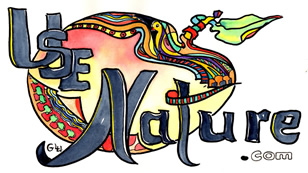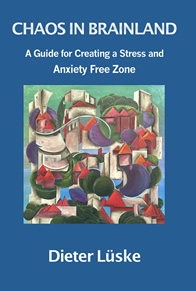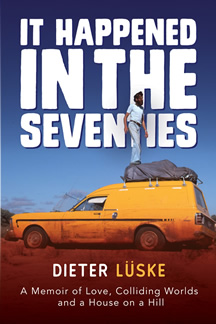useNature.com ... Brain Plasticity & Chronic Pain Visualisation Therapy
Brain Plasticity - Visualisation
General Pain Treatment Protocols
Visualisation Treatment Techniques
Article: Chronic Pain Visualisation Treatment Techniques
Brain Plasticity - Chronic Pain - Part 2
Chronic Pain Treatment - Continued
..... by Dieter Luske N.D.-D.C.H.-D.M.H.-D.H
Holistic Therapy Consultant - Gold Coast - Canungra
Author of It happened in the seventies ... and ...
|
Additional Visualisation Treatment Techniques:
The following techniques are a combination of well known Counselling and Neuro Linguistic Programming Techniques.
Remember, it is not only what you visualise, it is the fact, that you Do Visualise.
Visualisation by itself will take over neural pathways from pain centres.
However, special designed techniques have been particular successful in having long lasting effects on the brain and your mind.
-
Acknowledgement:
Before starting visualisation, acknowledge your brain by saying: "thank you, for alarming me that I have a problem that needed attention. I have attended to it, please stop alarming me now". -
Visualization support technique:
Your brain is accessing different senses in different parts of the brain, to support your brain accessing those senses move your eyes into specific directions:
For Visualisation - look up - you may close your eyes, but under your closed eye lids, look towards your forehead.
For Auditory - hearing sounds - look straight ahead.
For Feelings - look down - ..... and yes, that's why depressed people look down, it is actually a bit harder to be depressed while you look up to the sky.
Hint: Pain is a feeling, avoid looking down, keep your eyes looking up, stay in your visualisation mood. - Read > Activating Emotional Choice -
Deleting neural memory pathways (Deleting your Pain) :
If your pain would be a picture, how would it look like: size, shape and colour?
Transfer this image onto a car windscreen that shatters into thousand pieces if hit it with a hammer!
Now, hit your pain picture on that windscreen with a hammer, and see it shattering into 1000 of pieces, and each time a piece of pain shows up again, hit it again, have real fun with it, keep hitting it till the picture does not come up anymore.
Follow that up with visualising your pleasant number 2 picture of the "no pain brain image".
-
Physical Anchor technique explained ( what is an anchor):
Have you noticed a tennis player forming a fist, saying, "YES," after making a good shot? - That Tennis player has anchored a positive feeling to a fist. Next time that player makes a fist, the anchor will fire up that positive feeling again.
You can set your own anchor by making a fist, or instead press thumb & forefinger together, each time you have a real happy and pain free feeling.
After you have done that for a 3 days, you can start using the anchor to re-create that happy pain less feeling. -
Mental Anchor technique:
A mental association or mental anchor is achieved by repeating, in fast succession, a positive mental picture overlapping a negative mental picture.
visualise, how you look when having pain, then step into yourself, becoming that person, feeling the pain.
Say; "click" - making a picture of that image in your mind of yourself.
This picture should feel a bit bad, if not, choose a stronger pain associated picture, (you need to trigger a bad feeling to make this work).
If you have that strong picture, put a "black frame" around it.
This is now your bad picture, framed..
Open your eyes, and close them again, can you get that bad picture back again, quickly?
Train, till it comes back quickly, with the bad feeling attached to it.
Close your eyes again, and this time you see yourself the way you would as if you had No Pain.
This should create a strong positive happy feeling, if it does; say click - making a picture of that image of yourself.
Call this the good picture, and shrink it, into passport picture size.
Now comes the change over; within 10sec., see the bad framed picture, put the good passport size picture into a "sling shot", and shoot it into the bad picture, and quickly enlarge the good picture and make it bright and beautiful, until it covers all your mental vision, making you feel good.
Now open your eyes and close them again, and repeat the full process five times, fast, opening your eyes between.
NOTE: If the bad picture still comes back easily, repeat that process, till you find it hard to trigger the bad picture.
If you have pain again, the bad pain picture will help to trigger the good picture, which can be followed up by visualising the "brain without pain" picture
Remember, it always depends how strongly and effectively you visualise and how strongly you can feel your emotions. -
Explaining Association and Disassociation for visualisation.
There are two states of visualisation;
The first one is visualizing seeing you, like you would see yourself in a movie. This is the disassociated version.
The second one, is where you are behind the movie camera, and you visualise your surroundings, or look down on yourself seeing your body. This is when you are associated with yourself, meaning the visualisation is the same as the real you.
How can you use this?
In the associated state everything is like real; you feel, hear, see, taste and smell. It also means you feel the pain.
If you visualise in a disassociated state, you just see yourself like another person, therefore you don't feel the pain, and you can't feel, hear, see, taste and smell either.
That is the state, to help you to minimise your own pain.
In your normal day to day "thinking" which comes with visualisation, train yourself to be disassociated if appropriate. That way, you don't add to your pain, and because you are "visualising" you actually minimise your pain.
Being disassociated basically means you are detached from yourself, you see yourself as a "third person", therefore you also can be very objective.
NOTE: This technique can be very powerful, make sure that in situation you need or like to feel something, your visualisation is associated.
-
Art Activities
Learning to draw or paint is surprisingly effective for a number of problems. The effect is subtle at first, but can be life changing.
Some basic advantages of learning to draw:
Drawing relies on "vision" and visualizing, also on creation and intuition, as well as seeing the big picture. All these mental states are accessed within the right side of the brain, which will help to "pinch" back neuron pathways from the pain affected areas. Drawing is a meditative state and allows you to enter a state of Alpha Relaxation, a very pleasant state, where time and space seem to vanish.
-
And finally ..... Sound & Music
Similar properties to art, and you can lose yourself in music. Find your own kind of music to escape into a painless space, or listen to purposely designed music or sounds for brain health or different brain wave states.
Brian Plasticity Sound therapy have been already deveoped with great success. Our own research team is working on a Tinnitus treatment.
See more info: Alpha Brainwave
Brain Visualisation Picture Drawing Templates, to be PRINTED out and COLOURED IN
Copy template - colour it in - look at it intensely - close eyes and visualize it - open eyes - close again, repeat till you can visualize the picture easily.
Do the same with the second picture.
Brain in Pain
Colour In - Picture Template

Brain in Pain
Example of colouring in

Brain in "NO" Pain
Colour In - Picture Template

Brain in "NO" Pain
Example of colouring in
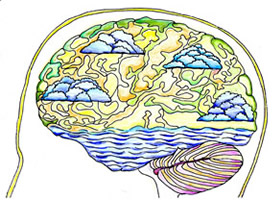
For a larger template to colour in, please contact me; Dieter L. - Editor - I will e-mail it ...
For stress reducing Colouring In Templates, or Colouring in Classses see: Adult Colouring In
... the next article is on: .... Art and Brain Plasticity
... or go back to the main Brain Plasticity Menu
Please contact me directly for more info or Research Participation: Dieter L. - Editor
... more colouring in therapy templates
* Disclaimer - Any general advice given in any article should not be relied upon and should not be taken as a substitute for visiting a qualified medical Doctor.
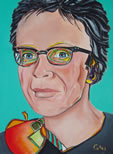 Dieter Lüske - Editor
Dieter Lüske - Editor
N.D.-D.C.H.-D.M.H.-D.H
Editor's Articles
Brain Plasticity Menu
Buy Now
It happened in the seventies
A Memoir of Love, Colliding Worlds and a House on a Hill
Intriguing story of personal risk-taking, self-discovery and profound change.
Dieter Luske
author . writer . editor
Holistic Brain Plasticity
© 1998 - 2025 useNature.com: Australia - Natural Health and Lifestyle Information Services - Books
Site Map - Terms / Privacy - Global Health | Free Alpha Music | Photography | Natural Links |
